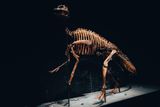Science
Dinosaur Mummies Unearthed in Wyoming Reveal Hooves and More

Researchers have discovered two remarkably preserved specimens of the dinosaur Edmontosaurus annectens in Wyoming, revealing unique features such as horse-like hooves and a duck bill. These discoveries, published in the journal Science, unveil the surprising details of how these dinosaur “mummies” were preserved under a thin layer of clay.
A Glimpse into the Past
Edmontosaurus annectens, a species that thrived in the late Cretaceous period, is part of the hadrosaurid family, commonly known as “duck-billed dinosaurs.” These creatures roamed the western United States, with fossils found in states like Wyoming and Colorado, as well as in Canada’s Saskatchewan and Alberta. The newly studied specimens, a late juvenile approximately 2 years old and an early adult aged between 5 to 8 years, were located in an area named the “mummy zone” due to the unusual preservation of their remains.
Paleontologists typically encounter dinosaur remains in the form of fossilized bones, which can last millions of years. In contrast, these two Edmontosaurus specimens were preserved in a way that retains their physical features, including skin and spikes, outlined in sediment.
Mummification Process Explained
The researchers, led by paleontologist Paul Sereno from the University of Chicago, investigated how these dinosaurs became mummies. They determined that a flash flood buried the carcasses, subsequently creating a biofilm that drew clay from the surrounding sediment to envelop them. While the organic materials decomposed, a clay film measuring only 1/100th of an inch thick preserved a 3D template of the dinosaurs’ bodies.
“This is a mask, a template, a clay layer so thin you could blow it away,” stated Sereno.
This method of preservation is unprecedented for dinosaur fossils, as it provides a rare glimpse of soft tissue features that are usually lost over time.
Using advanced imaging techniques like micro-CT scans and X-ray spectroscopy, the team outlined several distinctive features of E. annectens. These dinosaurs had a fleshy crest along their neck and trunk, transitioning into a row of spikes on their tails. Their scales were notably small, ranging from 1 to 4 millimeters, while wrinkles across their ribcage indicated that their skin was thin.
The most astonishing discovery involved the dinosaurs’ hooves. Researchers reconstructed these features by analyzing CT scans and comparing them with 3D images of other duck-billed dinosaur footprints. They found that each of the dinosaur’s three hind toes was encased in a wedge-shaped hoof, similar to those of horses.
Sereno noted the importance of these findings, stating, “There are so many amazing ‘firsts’ preserved in these duck-billed mummies — the earliest hooves documented in a land vertebrate, the first confirmed hooved reptile, and the first hooved four-legged animal with different forelimb and hindlimb posture.”
This research not only expands our understanding of Edmontosaurus but also highlights the complexities of dinosaur evolution and adaptation. As scientists continue to explore the “mummy zone,” further insights into the lives of these ancient creatures may come to light.
-

 Science2 months ago
Science2 months agoInventor Achieves Breakthrough with 2 Billion FPS Laser Video
-

 Health2 months ago
Health2 months agoCommunity Unites for 7th Annual Into the Light Walk for Mental Health
-

 Top Stories2 months ago
Top Stories2 months agoCharlie Sheen’s New Romance: ‘Glowing’ with Younger Partner
-

 Entertainment2 months ago
Entertainment2 months agoDua Lipa Aces GCSE Spanish, Sparks Super Bowl Buzz with Fans
-

 Health2 months ago
Health2 months agoCurium Group, PeptiDream, and PDRadiopharma Launch Key Cancer Trial
-

 Top Stories2 months ago
Top Stories2 months agoFormer Mozilla CMO Launches AI-Driven Cannabis Cocktail Brand Fast
-

 Entertainment2 months ago
Entertainment2 months agoMother Fights to Reunite with Children After Kidnapping in New Drama
-

 World2 months ago
World2 months agoR&B Icon D’Angelo Dies at 51, Leaving Lasting Legacy
-

 World2 months ago
World2 months agoIsrael Reopens Rafah Crossing After Hostage Remains Returned
-

 Business2 months ago
Business2 months agoTyler Technologies Set to Reveal Q3 Earnings on October 22
-

 Health2 months ago
Health2 months agoYouTube Launches New Mental Health Tools for Teen Users
-

 Health2 months ago
Health2 months agoNorth Carolina’s Biotech Boom: Billions in New Investments









